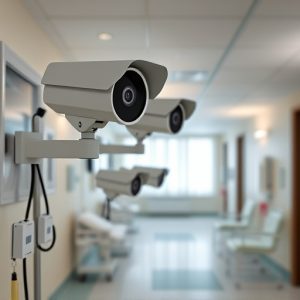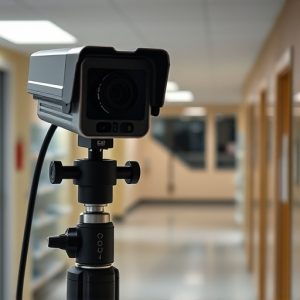Balancing Safety and Privacy with Camera Technology in Nursing Homes
Cameras in nursing homes play a vital role in ensuring resident safety and well-being by providing …….
Cameras in nursing homes play a vital role in ensuring resident safety and well-being by providing reassurance without compromising privacy. These systems are strategically placed to monitor common areas, deterring neglect or abuse while promoting adherence to care standards. They offer enhanced features like motion detection for prompt staff responses to resident needs, potentially preventing falls and other incidents. The analysis of footage helps refine safety measures within the facilities. Advanced camera systems with AI capabilities are being introduced to predict potential issues before they occur, enhancing the overall quality of life for seniors by fostering a secure environment that respects their dignity. Legal compliance with regulations like HIPAA is paramount, and informed consent from residents or their representatives is required. Ethical considerations guide the placement and use of cameras to protect resident privacy while maintaining community safety. Nursing homes must adopt clear surveillance policies, ensure staff training on privacy laws, and commit to upholding resident rights through responsible monitoring practices. As technology advances, we can expect to see more discreet, AI-driven solutions that offer non-invasive, privacy-respecting monitoring, contributing to a safer living environment for seniors with respect to their autonomy and dignity. These advancements aim to harmonize safety with individual choice, ensuring caregivers have the necessary tools to deliver high-quality eldercare.
Navigating the intersection of technology and eldercare, the integration of cameras for nursing homes has emerged as a topic of significant debate. This article delves into the multifaceted implications of this technology, examining its potential to enhance safety and well-being in senior living environments. We explore a spectrum of camera options tailored for these facilities, considering their capabilities and limitations. Furthermore, we address critical legal considerations and privacy concerns inherent to their deployment. By outlining best practices and strategies for implementation, the article aims to provide a clear framework for the ethical use of cameras in nursing homes. Additionally, we cast an eye towards future trends, anticipating how surveillance and monitoring technologies will continue to shape the senior living landscape.
Evaluating the Role of Cameras for Nursing Homes: Enhancing Safety and Well-being
Cameras for nursing homes play a pivotal role in enhancing safety and well-being among residents. These visual monitoring systems can provide peace of mind to both residents and their families, knowing that their loved ones are under watchful eyes without intrusive surveillance. The integration of cameras specifically designed for senior living environments helps in deterring potential neglect or abuse, ensuring that the care provided aligns with the expected standards. Moreover, these advanced systems often come equipped with features like motion detection, which can alert staff to a resident’s needs promptly, potentially preventing falls or other incidents. The footage can also be reviewed later to understand better the circumstances surrounding an event and to improve safety protocols within the facility.
Furthermore, the strategic placement of cameras for nursing homes allows for a non-invasive way to monitor residents’ activities and behaviors. This data can be instrumental in tailoring care plans to each individual’s needs, fostering an environment that respects privacy while promoting safety. Additionally, these systems can support staff by providing them with real-time feedback on the effectiveness of their interventions, leading to more responsive and personalized care. The use of cameras in nursing homes is not just about surveillance; it’s a multifaceted approach to ensuring the highest quality of life for seniors, balancing safety, autonomy, and respect for dignity.
Camera Technology Options for Senior Living Facilities: A Comprehensive Overview
In recent years, the integration of camera technology in senior living facilities has become a topic of significant interest among care providers and technologists alike. The right cameras for nursing homes can significantly enhance safety, security, and the overall well-being of residents. There are various technological options available, each with its unique advantages and applications. High-definition (HD) cameras with night vision capabilities ensure that activities within the facility remain under watch even in low-light conditions or during the night, providing peace of mind for both residents and their families. Motion-activated cameras can detect unusual activity, alerting staff to potential issues without invading privacy. Additionally, advanced camera systems equipped with AI and machine learning algorithms can analyze footage to predict and prevent incidents before they occur, offering a proactive approach to safety in senior living environments.
When selecting cameras for nursing homes, it is crucial to consider the specific needs of the facility, including the layout, resident preferences, and privacy concerns. Cameras should be strategically placed to cover high-traffic areas like common rooms, dining areas, and hallways while respecting the personal spaces of residents. The use of discreet cameras and one-way mirrors can provide necessary surveillance without being overly intrusive. Moreover, wireless technology allows for flexible placement and easier maintenance, ensuring that the camera system is both efficient and adaptable to the changing needs of the facility. These technological advancements are designed to support a safe, secure, and comfortable living environment for senior residents.
Legal Considerations and Privacy Concerns in the Use of Cameras in Nursing Homes
In recent years, the integration of cameras for nursing homes has been a topic of considerable debate, particularly concerning legal considerations and privacy concerns. Facilities must navigate complex legislation that varies by jurisdiction to ensure compliance with laws protecting residents’ rights to privacy while utilizing surveillance technology to safeguard their well-being. The use of cameras in these settings must align with regulations such as the Health Insurance Portability and Accountability Act (HIPAA) in the United States, which dictates the handling of individuals’ health information. Moreover, state laws may impose additional restrictions on recording individuals without consent. Facilities are obliged to obtain informed consent from residents or their legal representatives before installing cameras, clearly outlining the purposes and scope of surveillance.
Privacy concerns are paramount when considering the deployment of cameras for nursing homes. Residents have a right to expect that their personal spaces and activities will remain private unless there is a clear need and consent for monitoring. The ethical implications of surveillance must be carefully considered, ensuring that any intrusion into residents’ privacy is justified by a legitimate goal, such as protecting them from abuse or neglect. Cameras should be strategically placed to respect individual dignity while providing oversight to maintain safety and security within the community. It is imperative for nursing homes to establish transparent policies regarding camera usage, to regularly review and update surveillance practices in line with residents’ evolving needs and legal standards, and to provide training for staff on privacy laws and ethical surveillance.
Implementing Cameras for Nursing Homes: Best Practices and Strategies
Implementing surveillance cameras in nursing homes is a sensitive yet critical aspect of modern senior care. These systems can enhance safety, security, and provide peace of mind for residents and their families. When integrating cameras for nursing homes, it’s crucial to prioritize the privacy and dignity of residents. Best practices include selecting discreetly placed cameras that monitor common areas without intruding on personal spaces. The footage should be stored securely with limited access to ensure data protection and compliance with relevant regulations, such as HIPAA in the United States.
Strategies for effective camera implementation involve thorough planning and stakeholder engagement. Collaborating with residents, families, staff, and legal experts during the decision-making process is essential. Training staff on the ethical use of cameras, establishing clear protocols for monitoring and reviewing footage, and regular maintenance checks are all components of a responsible surveillance system. Additionally, it’s important to regularly evaluate and update the camera system to adapt to technological advancements and evolving privacy standards in senior living environments. By adhering to these best practices and strategies, nursing homes can harness the benefits of surveillance technology while respecting the rights and comfort of their residents.
Future Trends: The Evolution of Surveillance and Monitoring in Senior Living Communities
As technology advances, the integration of cameras for nursing homes is becoming increasingly sophisticated and tailored to enhance the safety and well-being of residents. Future trends indicate a shift towards discreet and non-invasive monitoring systems that respect the privacy and dignity of senior living inhabitants while ensuring their security. The evolution of surveillance technology in these communities is moving away from traditional CCTV setups and towards AI-driven solutions capable of detecting anomalies, identifying potential health issues early, and even facilitating interaction with healthcare providers remotely. These advancements promise to provide real-time data and alerts to staff, enabling prompt responses to emergencies and fostering a safer environment for all residents.
Moreover, the development of cameras for nursing homes is also focusing on integrating seamlessly into the ambiance of senior living spaces, with designs that blend into the architecture and operate through smart home technology. This not only provides a more aesthetically pleasing living space but also allows for more nuanced monitoring that can adapt to the changing needs and behaviors of residents. The aim is to create a harmonious balance between safety and autonomy, empowering seniors with the assurance that their welfare is being monitored in a respectful and effective manner, while simultaneously providing caregivers and staff with the tools they need to maintain a high standard of care.


